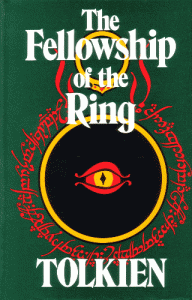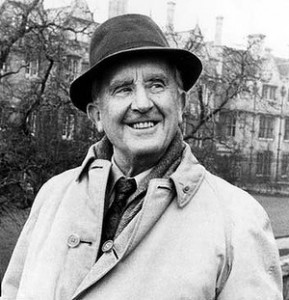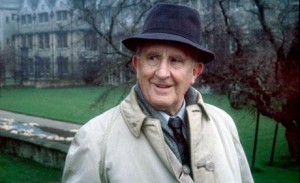The depth of the allegory is key, for it is primarily a fundamental element; The Lord of the Rings, which is directly related to The Silmarillion, thus has less an appearance of allegory because it takes place on a different textual level. This case, however, renders the allegory all the more explicit, for it is ever cunningly developed.
 Even so, Tolkien knew there was allegory in The Lord of the Rings that came across clearly. One reader, the author of letter #142, referenced above, wrote to him with some questions, one of which was the relation of Galadriel to the Virgin Mary. Tolkien’s response is twofold. First, he replies that the reader was “more perceptive, especially in some directions, than anyone else, and have even revealed to [him] more clearly some things about [his] work” (Tolkien 172).
Even so, Tolkien knew there was allegory in The Lord of the Rings that came across clearly. One reader, the author of letter #142, referenced above, wrote to him with some questions, one of which was the relation of Galadriel to the Virgin Mary. Tolkien’s response is twofold. First, he replies that the reader was “more perceptive, especially in some directions, than anyone else, and have even revealed to [him] more clearly some things about [his] work” (Tolkien 172).
One of these “things” so revealed is the association of Galadriel and Mary, the latter “upon which [Tolkien’s] own small perception of beauty both in majesty and simplicity is founded” (Tolkien 172). It is a grand statement indeed that Tolkien’s idea of beauty, a fundamental element of his works, is so admittedly tied to this religious figure; yet it is a controversy that cannot be refuted, for the Professor himself so makes the claim. Another example is his explanation of the role of “grace” in the trials of Frodo.
Tolkien defines “grace” as the “enhancement of our powers as instruments of Providence;” and to him, Frodo is given grace on a few occasions: first, in answering the Council of Elrond’s call, then in resisting the Ring’s temptation, and also in enduring the burden of carrying it (Tolkien 326). While these aspects may have slipped in unconsciously in the beginning, their development in the text, along with the allegory, became a conscious one, and in that conscious assembly is to be found the reason for such excellent subtlety.
Tolkien cedes further that “‘allegory’ is the only mode of exhibiting certain functions,” which, in the context of the most bemusing and vexatious Tom Bombadil, and other instances where allegory may seem more explicit, Tolkien finds applicable (Tolkien 192). The mystery of Tom, long confounding readers, is readily described by Tolkien and cogently unraveled: he is “embodying…pure (real) natural science,” to be thought of as “zoology and biology not cattle-breeding or agriculture” (Tolkien 192). The nature of Tom Bombadil in the author’s eyes, wherein we may find some semblance of the character’s true raison d’être, is exemplary of the hidden allegory within the author’s application.
The Valar embody another level of entextualized allegory. They are the “gods,” but as yet beneath the God, Eru, the One, and they remain his agents. Appropriately so, the inhabitants of the living world may “call on a Vala…as a Catholic might on a Saint” (Tolkien 193).
 This is a most direct comparison, and not employed solely for illustrative benefit. What is clear from the mythology is that the relationship between those “below” and those “above” is one of invocation for aid; Tolkien himself cites the calls to Elbereth throughout the text. We must also examine the relationships of the “gods” to each other, and theirs with the God, Eru. The nature of power dynamics, coupled with the notion of the Fall above, reveals that conflict amongst the prevailing powers drives the story and remains a constant factor across time (with Morgoth as Satan fallen from grace, this eternal conflict is all the more lucidly imagined).
This is a most direct comparison, and not employed solely for illustrative benefit. What is clear from the mythology is that the relationship between those “below” and those “above” is one of invocation for aid; Tolkien himself cites the calls to Elbereth throughout the text. We must also examine the relationships of the “gods” to each other, and theirs with the God, Eru. The nature of power dynamics, coupled with the notion of the Fall above, reveals that conflict amongst the prevailing powers drives the story and remains a constant factor across time (with Morgoth as Satan fallen from grace, this eternal conflict is all the more lucidly imagined).
Yet Tolkien goes so far as to say that the conflict in The Lord of the Rings is really “about God, and His sole right to divine honour” (Tolkien 243). The conflict began with Morgoth, whom Sauron followed to the “depths of evil,” and quickly became his agent; and it appears to first climax when Sauron attempts to inveigle the Numenoreans into making him a “God-King,” all of which poses a challenge to God and the carrying out of his will (Tolkien 243). The chief crime is, however, not in his direct challenge to God, but rather in how he would sway the true, monotheistic hearts of the children of God into believing that he was the One.
Ultimately, God’s will prevails, and the War of the Ring brings down Sauron. However, had he won, Sauron would have “demanded divine honour from all rational creatures and temporal power over the whole world;” that is, Sauron, in an act of near-absolute evil, would have decreed himself God (Tolkien 244).
Tolkien assures critics that this is “not any kind of new religion;” rather, it is “to express…some of [his] (dim) apprehensions of the world” (Tolkien 283). Indeed, it is not a new religion and it most certainly expresses a part of Tolkien’s world: his religion.
The theme of power, especially in a religious context (struggles between the children of God for power, between them and God, and between God and his servants), is present. The theme of death and immortality—that is, life—is also present in a religious context, as the children of God struggle to understand their situation. Men wish to know why they must die, and Elves why they find no rest in permanence. Yet as the races, the children of God, question each other and themselves, they also question God, and on occasion (not Beren and Luthien), they pose a direct challenge to him.
Tolkien, with this in mind, admits his tale “is built on or out of certain ‘religious’ ideas,” yet still hesitates to call it allegory because it “does not mention them overtly, still less preach them” (Tolkien 284-84). I believe the problem lies in his definition of and ostensible scorn for allegory, as it is plain that some aspect of this tale must be allegorical. For one, I hope to shown that subtlety—as he says, not being overt—does not rule out the presence of allegory. His tales may not be preachy, as most bad allegories are, and thus he is more than pleased to write off the possibility.
But if we look at allegory as a finely developed, deeply-entrenched craft, as Tolkien so cunningly renders by rooting his tales in the context of The Silmarillion, he would perhaps not so disdain the notion, where it is now one of avowed and clear skill in his art, and not some cheap trick to get off a novel. It is clear that Tolkien’s is a type of allegory, and that there is a place for it on the continuum, far, far away from the works that account for his abhorrence of the notion.
 A deeply religious sense permeates Tolkien, and a clear picture of the theologian he was can be found in Letters. But his religious identity is often seen as secondary to Lewis’, though much of Tolkien’s corpus could have been compiled into a theological tome had he, or his publishers, so desired. By this I mean that his reputation is wrongfully diminished, and this misrepresentation adds to the mess of opposing ideas in the “allegory-applicability” debate.
A deeply religious sense permeates Tolkien, and a clear picture of the theologian he was can be found in Letters. But his religious identity is often seen as secondary to Lewis’, though much of Tolkien’s corpus could have been compiled into a theological tome had he, or his publishers, so desired. By this I mean that his reputation is wrongfully diminished, and this misrepresentation adds to the mess of opposing ideas in the “allegory-applicability” debate.
If we can begin to acknowledge and internalize how religious Tolkien was—on an academic and personal level—something which seems so antithetical to a scholar of the man, we will be shown a much more faithful portrait and accurate representation of his life and works; at which point, the presence of allegory may not be wholly unlikely.
I am not advocating for a religious reading of all Tolkien’s works; indeed, I am not advocating for a religious reading of any of them. I am content to enjoy them simply as they are. But it is clear that the mess of confusion and doubt about allegory and Tolkien is a quagmire in which scholarship has been either bogged down for too long, or stopped on the edge, afraid to enter the fray. It is, however, wrong to refuse to accept that allegory may be present in the texts simply because Tolkien may have disliked that notion, rather, his notion thereof.
Yet it is lunacy to continue refusing that allegory may be present when the author himself outlines his own intended, or understood, allegory as completely and deeply as Tolkien. In his words, “each of us is an allegory, embodying in a particular tale and clothed in the garments of time and place, universal truth and everlasting life” (Tolkien 212).
Works cited:
J.R.R. Tolkien, The Letters of J.R.R. Tolkien, ed. Humphrey Carpenter with the assistance of Christopher Tolkien (Boston: Houghton Mifflin, 2000)
Tedoras is a bibliophile, linguist, and regular attendee at TORn’s live weekly webcast. He splits his time between scouring the web for Tolkien books to add to his collection and the study of Chinese politics and public policy.


